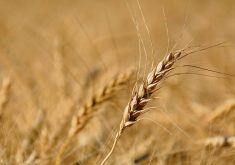Chickpeas and fababean crops graded in Canada will have a new maximum tolerance for ergot next year, even though the cereal disease doesn’t occur in either crop.
The Canadian Grain Commission on Wednesday announced an ergot tolerance of 0.05 per cent for all grades of fababeans and chickpeas in Western Canada effective Aug. 1, 2017, and for all grades of fababeans in Eastern Canada effective July 1, 2017.
The commission said its concern for ergot — a fungal cereal disease, producing alkaloids which are toxic to people and livestock — is that cross-contamination could occur in chickpeas or fababeans during handling.
Read Also

India slaps 30 per cent import duty on yellow peas
India has imposed a 30 per cent duty on yellow pea imports with a bill of lading date on or after Nov. 1, 2025.
Setting a 0.05 per cent tolerance for ergot in fababeans and chickpeas “will help guarantee the safety of Canadian grain” and lines up with other pulse crops in Canada’s Official Grain Grading Guide.
Grasshopper, army worm damage
The CGC on Wednesday also announced a tighter grading tolerance for grasshopper and army worm damage in three grades of wheat, effective Aug. 1, 2017.
At that date, the tolerance level for such damage in No. 3 Canada Western Red Spring (CWRS), No. 3 Canada Western Hard White Spring and No. 3 Canada Northern Hard Red wheat will be cut to six per cent, from the current eight per cent.
Research has shown eight per cent grasshopper and army worm damage in those wheats “can impact end-use functionality,” the CGC said.
The CGC on Wednesday also announced new standard samples for No. 1 Canada Yellow soybeans, Nos. 1 and 2 Canada Yellow peas and No. 2 Canada Green peas, and new mildew guides for Nos. 1, 2 and 3 CWRS wheat, Nos. 1, 2 and 3 Canada Western Amber Durum and Nos. 1 and 2 Canada Western Red Winter wheat.
Those new standard samples and guide samples took effect as of Tuesday, the CGC said. Standard samples and guide samples previously adopted for other grades and grains will continue to be used. — AGCanada.com Network












